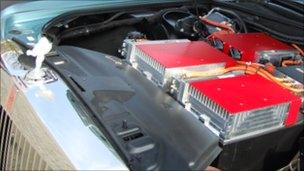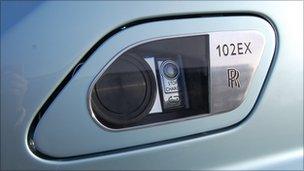Driving the electric Rolls-Royce
- Published
Watch: Jorn Madslien takes a look at the Phantom Experimental Electric
BBC motoring writer Jorn Madslien is one of the first people outside Rolls-Royce to have driven the company's newly built electric car. So, is it any good?
The silence is, if not deafening, then at least spine-tingling as the 2.7 tonne Rolls-Royce Phantom effortlessly takes off down the drive of the carmaker's Goodwood factory.
The only sound is a slight tyre noise, and even that is barely audible inside the luxury car's insulated cabin.
Seated deep in the soft, hand-stitched leather seat, accelerating along narrow Sussex country lanes, the car feels marginally less stable than the conventional Phantom, especially as it conquers the bendy road beyond East Lavington towards Duncton.

The battery pack in the Rolls-Royce is the biggest yet fitted to an electric car
And once motoring along the straights between Cocking and Singleton, it is easy to feel somewhat disconnected from the machine in motion and miss the rumbling sensation - rather than any sound - of the petrol-powered version's exceptionally quiet V12 engine.
For Autobahn warriors, the electric Rolls-Royce may even come across as slow, what with its top speed capped electronically at 100mph (160 km/h) - though it accelerates from nought to 60mph in about eight seconds.
Some might also grumble about the car's limited range - estimated at about 125 miles on one charge of the biggest battery yet to be fitted in an electric car.
Why buy it?
So clearly, an electric Rolls will not be everyone's cup of tea.
But Rolls-Royce owners come in many guises.
Some of them would never dream of travelling further than 125 miles by car; for longer journeys they might prefer helicopters or private jets.
Watch: Torsten Muller-Otvos, CEO of Rolls Royce says he wants to know if people will buy the electric Phantom
Others might fall in love with the marginally more silent experience in the back seat - and the difference really is marginal. Or they might enjoy the somewhat smoother acceleration delivered by the constant torque of the electric motor.
There are Rolls-Royce customers who buy cars simply because they can. Some of those might well be keen to add an electric version to their collections - perhaps in addition to their petrol-powered version, or versions.
And then there are those who adore technology and who would want to buy one simply because it is a great car, or perhaps because it is electric rather than petrol-powered - a virtue that might attract new buyers with green instincts, or those who simply want to cultivate a green image.
Automatic charging
But much of this is academic at best, or really little more than pure speculation.
In truth, Rolls-Royce has no idea what its customers might think about the car, or whether they would like to buy one.
And this is exactly why they have built it.
Over the next few months, some 500 existing owners will be invited to drive the car as the company seeks to find out whether they might be prepared to accept Rolls-Royce models powered by anything other than a large petrol engine.

The electric Rolls-Royce can be plugged in, though users might prefer using an induction plate
From inside the car's cabin, there are few, if any, reasons why they would object.
The Rolls-Royce 102EX Phantom Experimental Electric, as it is formally known, is every bit as refined as the conventional version.
In fact, for those owners who do not care about the stuff under the bonnet it really should make no difference whether the car is powered by an electric motor or a petrol engine.
If anything, the electric version makes life simpler as it comes with an electric induction plate that is built into the owner's garage floor.
Park over it and the battery will automatically be recharged - though some 8% of of the electricity will be wasted in the name of convenience when compared with physically plugging it into a socket.
Pricey modification
When all is said and done, however, the inescapable truth is simple: the electric and petrol version of the Rolls-Royce Phantom are pretty much indistinguishable.
Except, that is, with regards to price.

The experimental car may prove to be an efficient marketing vehicle for Rolls-Royce
Rolls-Royce do not know how much the car would cost if they were to put it into production, though chief executive Torsten Muller-Otvos points out that electric cars that are currently for sale come with rather large price premiums.
"If you look at electric cars today and at what their price increase is, it's 50% - often more than 50% - and some of them are 100% more expensive," he observes.
So take the price of a Phantom and double it and the search could well be on for customers prepared to cough up something in the region of £600,000 ($960,000).
Attention-grabbing car
Such buyers exist, of course.
Indeed, there are those who would like the electric car, not in spite of but because it is more expensive than its conventional cousin, whilst others might have no interest in the price whatsoever.
If it turns out there is enough demand for the car, it could be ready for production in a couple of years, Mr Muller-Otvos says.
The battery pack fits snugly into the engine compartment and the electric motor goes where the petrol tank sits in the conventional model, so modifying the existing Phantom is not a hugely complex challenge.
But whether the economics stack up is another matter altogether.
"I need to make sure when we invest in an alternative drive train that at the end of the day it finds customers and that we see a return on that business," says Mr Muller-Otvos.
The best chance for a large enough market for an electric Rolls-Royce to emerge is probably regulatory pressures.
If cars with combustion engines are banned from city centres, as proposed by the European Union this week, external and discussed by authorities across the world, the number of interested buyers might well swell.
In the meantime, the attention-grabbing electric Rolls-Royce might earn its spurs as an effective marketing vehicle that powers the sales of its "gas-guzzling" cousin.
- Published1 March 2011
- Published10 January 2011